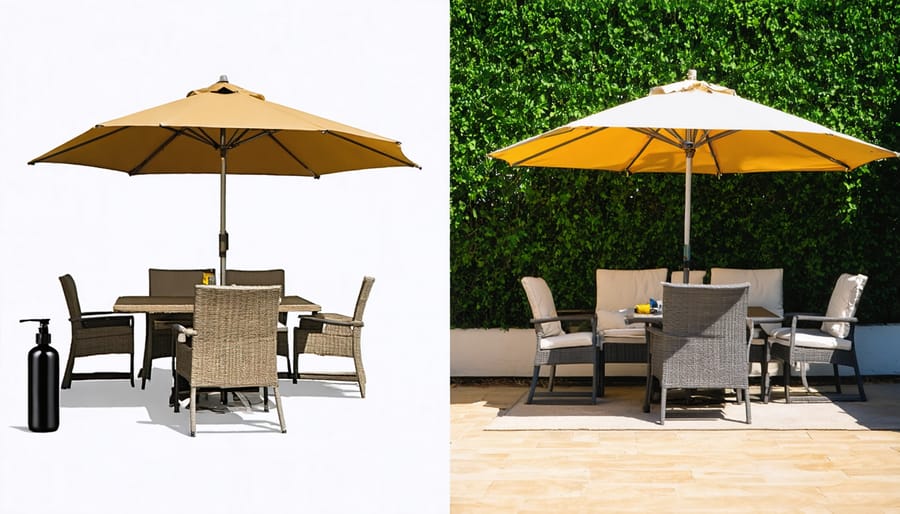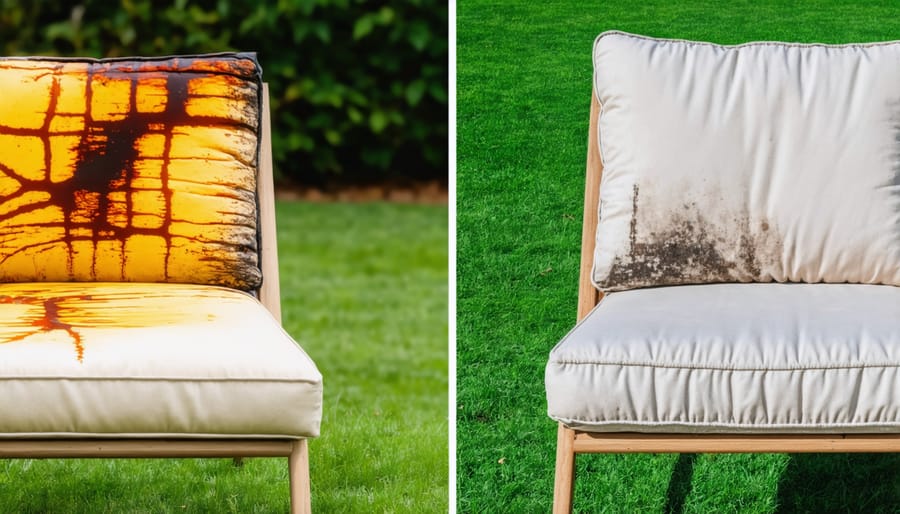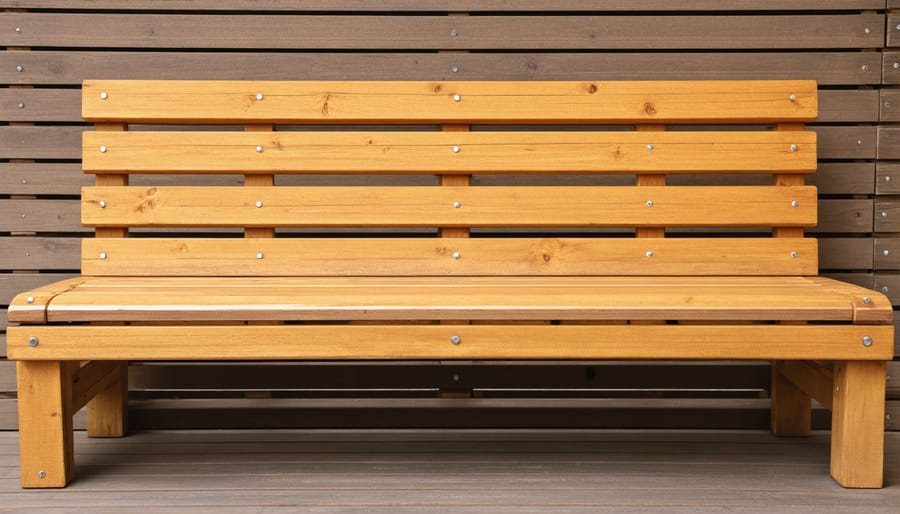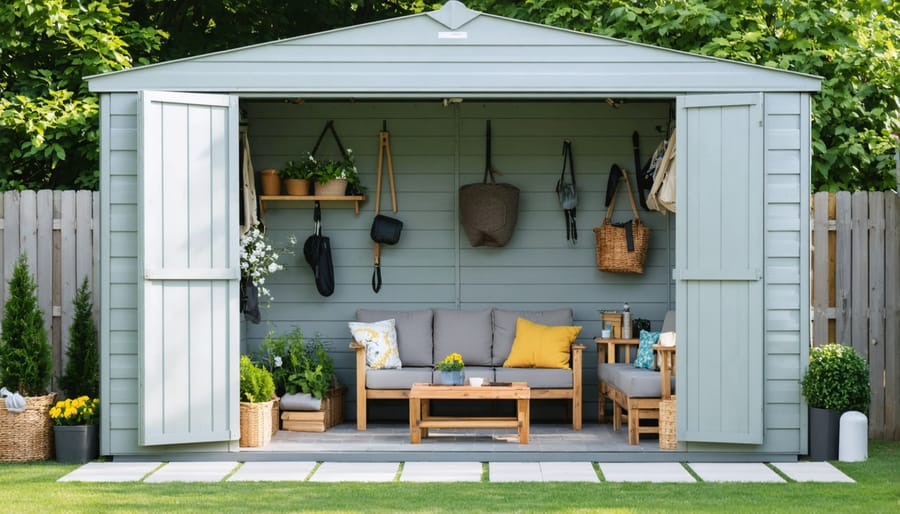Protect Your Outdoor Furniture from UV Damage (While Keeping Your Shed Safe)

Protect your outdoor furniture from harsh UV rays with a multi-layered defense strategy that preserves both appearance and structural integrity. Sunlight’s constant assault can fade colors, weaken materials, and significantly reduce the lifespan of your patio investments – but smart protection methods can extend their life by years. From high-quality furniture covers to UV-resistant sprays and strategic placement, proper sun protection isn’t just about preservation; it’s about maintaining your outdoor living space’s beauty and functionality for seasons to come.
Start by understanding that different materials require specific protection approaches. While teak naturally resists UV damage, synthetic wicker and fabrics need dedicated UV-protective treatments. Metal furniture, though durable, can become uncomfortably hot and experience color fading without proper protection. This guide explores proven methods to shield your outdoor furniture from sun damage, helping you make informed decisions about protection strategies that work for your specific pieces and climate conditions.
Understanding UV Damage to Outdoor Furniture
Common Materials and Their UV Vulnerability
Different outdoor furniture materials react uniquely to UV exposure, making it essential to understand their specific vulnerabilities. Wood furniture, especially untreated pieces, can fade significantly and develop a grayish patina when exposed to sunlight. The UV rays break down lignin, the natural compound that gives wood its color and strength, leading to potential structural weakening over time.
Plastic furniture faces perhaps the most severe UV challenges. Prolonged sun exposure can cause discoloration, brittleness, and cracking. Light-colored plastics tend to yellow, while darker colors may fade dramatically. The material can become weak and prone to breaking, particularly at stress points like armrests and joints.
Metal furniture, while generally more UV-resistant, isn’t entirely immune. Painted metal surfaces can fade and peel under intense sunlight, potentially exposing the base material to rust and corrosion. Aluminum typically performs better than steel in this regard.
Fabric elements, such as cushions and umbrella canopies, are highly susceptible to UV damage. The sun’s rays can cause severe fading and deterioration of fibers, leading to weakened fabric that may tear easily. Synthetic materials like polyester often show better UV resistance than natural fibers, though all fabrics benefit from protection.
Signs Your Furniture Needs UV Protection
Keep an eye out for these telltale signs that your outdoor furniture needs UV protection. Fading or discoloration, particularly in vibrant fabrics or dark-colored materials, is often the first indicator of sun damage. When your furniture feels rough or brittle to the touch, it’s crying out for protection. Watch for cracking or splitting in wooden pieces, and any plastic components that appear chalky or show surface cracks.
Cushions that feel stiff or show uneven coloring need immediate attention. For wicker or rattan furniture, look for fraying or brittleness in the weave. Metal furniture might show signs of oxidation or paint peeling, which can worsen with continued sun exposure.
Don’t wait until the damage is severe – when you notice any of these signs, it’s time to apply UV protection to preserve your furniture’s beauty and extend its lifespan.

Effective UV Protection Methods
UV-Resistant Coatings and Sealants
Protecting your outdoor furniture starts with applying the right UV-resistant coatings and sealants. These protective layers act as a shield between your furniture and harmful sun rays, preventing fading, cracking, and deterioration.
For wooden furniture, marine-grade sealants offer excellent protection while maintaining the natural beauty of the wood. Apply these with a high-quality brush or roller in thin, even coats, allowing each layer to dry completely before adding the next. Most wooden pieces benefit from 2-3 coats for optimal protection.
Metal furniture requires specialized UV-protective clear coats that prevent oxidation and rust. These typically come in spray form for easy application and even coverage. Before applying, ensure the surface is clean and free from any rust spots or debris.
For wicker and synthetic materials, UV-protective sprays designed specifically for these materials work best. These sprays penetrate the material while forming a protective barrier that’s both water-resistant and sun-blocking.
When applying any coating, choose a dry, mild day with temperatures between 50-80°F for best results. Work in a well-ventilated area and always test the product on a small, hidden area first. Reapplication is typically needed every 12-24 months, depending on exposure levels and local climate conditions.
Remember to clean surfaces thoroughly before application and allow proper drying time between coats for maximum effectiveness and longevity.

Protective Covers and Fabrics
Protective covers and UV-resistant fabrics serve as your first line of defense against harmful sun exposure for outdoor furniture. When selecting furniture covers, opt for materials specifically labeled as UV-resistant or UV-protected. Look for covers made from solution-dyed acrylic fabrics, which offer superior sun protection while remaining breathable to prevent moisture buildup.
Popular choices include Sunbrella and Outdura fabrics, known for their durability and fade resistance. These materials are treated with special UV inhibitors that block harmful rays while maintaining their color and structural integrity. For maximum protection, choose covers with additional features like water resistance, ventilation panels, and secure fastening systems.
The right fit is crucial – covers should be snug but not tight, with enough room to prevent water pooling. Consider covers with reinforced seams and double-stitching for longer life. Light-colored covers reflect more sunlight and heat, making them particularly effective in intense sun exposure areas.
When not using your furniture, keep covers in place, especially during peak sun hours. Remove covers periodically to check for trapped moisture and allow furniture to breathe. For seasonal storage, clean both the furniture and covers thoroughly before storing to prevent mold growth and fabric deterioration.
Remember that even the highest quality covers need replacement every few years, depending on climate conditions and usage patterns. Regular inspection helps identify wear and tear before serious damage occurs.
Strategic Placement and Storage Solutions
Strategic placement of your outdoor furniture can significantly reduce UV damage while maintaining your outdoor living space’s appeal. Position your furniture under existing structures like pergolas, awnings, or trees whenever possible. For areas without natural coverage, consider creating designated zones using retractable shade sails or umbrellas that can be adjusted throughout the day as the sun moves.
When not in use, particularly during harsh weather seasons, storing your furniture properly becomes crucial. A well-organized shed offers excellent weather-resistant storage solutions that protect your investments. Arrange your shed space vertically using wall-mounted hooks and shelving systems to maximize storage capacity. For larger pieces, consider installing overhead pulley systems to hoist chairs and tables off the ground.
Create a rotation system for frequently used items by keeping them near the shed entrance, while seasonal pieces can be stored deeper inside. Use furniture covers even within the shed for an extra layer of protection. If space is limited, consider stackable furniture or pieces that can be dismantled for compact storage.
Remember to leave adequate airflow around stored furniture to prevent moisture buildup. Installing small ventilation fans or dehumidifiers in your shed can help maintain optimal storage conditions, especially in humid climates.
Creating a UV-Protected Storage Environment
Window Treatments and Ventilation
Windows in your storage shed play a crucial role in protecting your outdoor furniture from harmful UV rays while maintaining proper airflow. To strike the right balance, consider installing UV-resistant window films that block up to 99% of UV radiation while still allowing natural light to enter. These films are easy to apply and can significantly reduce the sun’s damaging effects on your stored furniture.
Another effective solution is installing adjustable window blinds or cellular shades specifically designed for outdoor spaces. These allow you to control light exposure throughout the day while providing additional insulation. For maximum protection, look for blinds with a reflective backing that helps deflect UV rays.
To monitor storage conditions effectively, consider installing a proper ventilation system alongside your window treatments. Solar-powered vents or window fans can help maintain air circulation while reducing humidity levels that could damage your furniture.
For a budget-friendly option, UV-blocking curtains made from weather-resistant fabrics offer both protection and style. These can be easily adjusted to manage light exposure and complement your shed’s exterior. Remember to position windows strategically when building or modifying your shed, ideally avoiding direct afternoon sun exposure where UV radiation is typically strongest.
Organization Tips for Maximum Protection
Proper organization of your outdoor furniture in storage can significantly extend its protection against UV damage. Start by placing larger pieces like sofas and dining tables toward the back of your storage space, positioning them away from any windows or openings where direct sunlight might enter. This creates a natural barrier for smaller items placed in front.
Consider stacking chairs upside down when possible, using furniture covers as protective layers between pieces to prevent scratching while maximizing space. For cushions and fabric items, store them in sealed plastic containers with moisture-absorbing packets to prevent mildew growth during storage.
Create designated walkways between furniture pieces to allow air circulation, which helps prevent moisture buildup and potential damage. If using a shed or garage, install curtains or UV-filtering film on windows to provide an extra layer of protection against harmful rays that might slip through.
For seasonal items, rotate their positions periodically to ensure even exposure to any minimal light that enters the storage space. Keep frequently used pieces near the entrance for easy access while maintaining the protective barrier of larger items behind them.
Label your furniture arrangements with simple diagrams or photos to help maintain organization when removing and returning pieces throughout the season. This systematic approach ensures consistent protection while making it easier to access your furniture when needed.

Maintenance and Long-term Care
Seasonal Protection Schedule
Regular UV protection maintenance follows a seasonal rhythm for optimal furniture care. Start in early spring (March-April) with a thorough cleaning and initial protective coating application before the intense summer sun arrives. During peak summer months (June-August), inspect furniture monthly and reapply protection if you notice fading or water beading becomes less effective.
For fall preparation (September), apply an additional protective layer to guard against harsh winter conditions. If storing furniture outdoors during winter, add an extra coat in late November for maximum protection. Keep in mind that furniture in direct sunlight needs more frequent treatment – possibly every 6-8 weeks during summer – while covered pieces may only need quarterly applications.
Pro tip: Mark your calendar with these key protection dates, and always test products on a small area first. Remember that high-traffic items like chair cushions and table tops may need more frequent attention than decorative pieces.
Cleaning and Protection Renewal
Regular maintenance of your UV-protective measures ensures long-lasting furniture protection. Start by gently cleaning protective covers with mild soap and warm water every few months, allowing them to air dry completely before reuse. For furniture with UV-resistant coatings, wipe surfaces monthly with a soft, damp cloth to remove dirt that could wear down the protective layer.
Inspect your furniture’s protective coating annually for signs of wear. When you notice the coating becoming dull or furniture showing signs of fading, it’s time to renew the protection. Apply a fresh coat of UV-protective spray or sealant following the manufacturer’s instructions, typically during dry weather with temperatures between 50-80°F.
For fabric items, refresh water-repellent and UV-protective treatments every 6-12 months, depending on exposure levels. Remember to clean cushions and covers thoroughly before reapplying any protective treatments, as dirt can prevent proper absorption and reduce effectiveness. Store removable cushions and covers indoors during severe weather to extend their protective properties.
Protecting your outdoor furniture from UV damage is not just about preserving its appearance – it’s an investment in longevity that pays dividends year after year. By implementing a comprehensive UV protection strategy, including regular application of UV-resistant coatings, strategic placement of furniture, and proper storage during harsh weather, you can significantly extend the life of your outdoor pieces. Remember that different materials require different approaches, so always match your protection methods to your specific furniture type.
Make UV protection part of your regular maintenance routine, checking furniture conditions monthly and reapplying protective treatments as needed. The small effort invested in consistent care will help maintain your furniture’s color, strength, and overall integrity. Consider combining multiple protection methods for the best results – using covers when furniture isn’t in use, positioning items thoughtfully to minimize direct sun exposure, and maintaining protective coatings.
By following these guidelines, you’ll ensure your outdoor furniture remains beautiful and functional for years to come, protecting both your investment and your outdoor living space’s aesthetic appeal.

